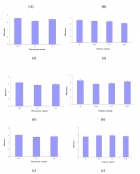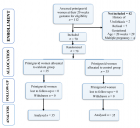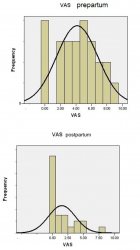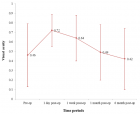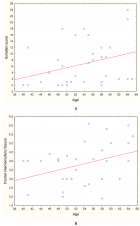Abstract
Research Article
Influence of adverse socio-emotional risk factors on the physical and mental health needs of children and young people in public care of a South-West England local authority
Michael O Ogundele*
Published: 29 April, 2020 | Volume 4 - Issue 1 | Pages: 001-009
Introduction: There is increasing published evidence confirming the long-term adult mental and physical health impact of childhood exposure to adverse events including different forms of abuse and family dysfunction. Looked-after Children and young people (LACYP) living in public care are known to be a highly vulnerable group, who have often experienced several pre-care poor socio-economic and family circumstances with subsequent placement instability, as well as inadequate compensatory care within the social care system. We aimed to evaluate the relationship between the adverse socio-emotional risk factors experienced by a cohort of LACYP and their emotional, behavioural and physical health needs within a South-West England Local Authority between Jan and Dec 2018.
Methods: We carried out a retrospective review of the medical records of all looked-after children and young people (LACYP) within one year (Jan to Dec 2018) at the North Somerset Local Authority (NSLA). This was an audit project of the LAC Health team completed as part of the Clinical Governance strategies of the NSLA.
Results: 93% (89/96) of the LACYP experienced at least one or more socio-emotional adverse risk factors. The commonest socio-emotional risk factors recorded were parent-related including poor mental health (67%), neglectful parenting (59%), drugs/alcohol abuse (45%) and domestic violence (47%). Forty-six (48%) of the LACYP had at least one or more emotional problems, 48 (50%) had neurodevelopmental conditions, while 63 (66%) had at least one or more physical problems. The most common emotional needs were behavioural problems (35%), anxiety/ depression (17%), nicotine/substance misuse (10%) and self-harm (6%).
Conclusion: High levels of physical, emotional, behavioral, developmental and neurodisability disorders are prevalent among LACYP due to their high vulnerabilities to adverse life experiences and trauma while living within their biological families. Present and future clinical implications of the socio-emotional risk factors and the need for more integrated multi-agency services for addressing the diverse health needs of the LACYP were discussed.
What is known?
• There is increasing awareness of the relationship between childhood exposure to adverse events and long-term adult mental and physical health
• Looked after children and young people (LACYP) are highly vulnerable to early traumatic and poor socio-economic circumstances exposure
What this study adds:
• Over 90% of LACYP experienced at least one ACE which disproportionately affected the youngest age-group
• Parental factors such as childhood abuse, alcohol/substance abuse and mental health problems were the most common adverse factors experienced by the LACYP
Read Full Article HTML DOI: 10.29328/journal.cjncp.1001021 Cite this Article Read Full Article PDF
Keywords:
Looked-after children; Integrated services; Mental health; Physical health; Adverse child experience; Fostering; Adoption
References
- Felitti VJ, Anda RF, Nordenberg D, Williamson DF, Spitz AM, et al. Relationship of Childhood Abuse and Household Dysfunction to Many of the Leading Causes of Death in Adults: The Adverse Childhood Experiences (ACE) Study. Am J Prev Med. 2019; 56: 774-786. PubMed: https://www.ncbi.nlm.nih.gov/pubmed/9635069
- Anthony RE, Paine AL, Shelton KH. Adverse Childhood Experiences of Children Adopted from Care: The Importance of Adoptive Parental Warmth for Future Child Adjustment. Int J Environ Res Public Health. 2019; 16: 2212. PubMed: https://www.ncbi.nlm.nih.gov/pubmed/31234480
- Teyhan A, Wijedasa D, Macleod J. Adult psychosocial outcomes of men and women who were looked-after or adopted as children: prospective observational study. BMJ Open. 2018; 8: e019095. PubMed: https://www.ncbi.nlm.nih.gov/pubmed/29439075
- Children in Need of help and protection: data and analysis: 2019.
- McCrory E, De Brito SA, Viding E. The impact of childhood maltreatment: a review of neurobiological and genetic factors. Frontiers in Psychiatry. 2011; 2: 48. PubMed: https://www.ncbi.nlm.nih.gov/pubmed/21847382
- Woolgar M. The practical implications of the emerging findings in the neurobiology of maltreatment for looked after and adopted children: Recognising the diversity of outcomes. 2013; 37: 237-252.
- Burton K. Chapter 2: The child's health. In: Merredew F and Sampeys C (eds) Promoting the Health of Children in Public Care. London: BAAF. 2015; 13-49.
- Department for Education (DfE) UK. Characteristics of Children in Need: 2017-2018. Headlines. London: Department for Education. 2019.
- Brandon M, Bailey S, Belderson P, Larsson B. The Role of Neglect in Child Fatality and Serious Injury. Child Abuse Review. 2014; 23: 235-245.
- Sempik J, Ward H, Darker I. Emotional and behavioural difficulties of children and young people at entry into care. Clin Child Psychol Psychiatry. 2008; 13: 221-233. PubMed: https://www.ncbi.nlm.nih.gov/pubmed/18540226
- Tarren-Sweeney M. The mental health of children in out-of-home care. Child and Adolescent Psychiatry. 2008; 21: 345-349. PubMed: https://www.ncbi.nlm.nih.gov/pubmed/28734200
- Ogundele MO. Clinical characteristics of children and young people looked after by a South-West England Local Authority in 2018. Advances in Pediatrics and Neonatal Care. 2019.
- Wessa P. Free Statistics Software, Office for Research Development and Education. 2019.
- The Children's Society. Good Childhood Report. 2017.
- Arango C, Díaz-Caneja CM, McGorry PD, Rapoport J, Sommer IE, et al. Preventive strategies for mental health. The Lancet Psychiatry. 2018; 5: 591-604.
- Children looked after in England (including adoption). 2017.
- Department of Health (DoH)/ DfE. Transforming Children and Young People's Mental Health Provision: A Green Paper. 2017
- Cusworth L, Biehal N, Whincup H, Grant M, Hennessy A. Children looked after away from home aged five and under in Scotland: experiences, pathways and outcomes. 2019.
- Croft G. Implementation of Health Recommendations after Initial Statutory Health Assessment. Adoption & Fostering. 2009; 33: 76-81.
- Walton S, Bedford H. Immunization of looked-after children and young people: A review of the literature. Child Care Health Dev. 2017; 43: 463-480. PubMed: https://www.ncbi.nlm.nih.gov/pubmed/28317146
- Anda RF, Felitti VJ, Bremmer JD, Walker JD, Whitfield CH, et al. The enduring effects of abuse and related adverse experiences of childhood. Eur Arch psy & clin neurosc. 2006; 256: 174-186. PubMed: https://www.ncbi.nlm.nih.gov/pubmed/16311898
- Hughes K, Bellis M, Hardcastle K, Sethi D, Butchart A, et al. The effect of multiple adverse childhood experiences on health: a systematic review and meta-analysis. Lancet Public Health. 2017; 2: e356-e366. PubMed: https://www.ncbi.nlm.nih.gov/pubmed/29253477
- Wadman R, Clarke D, Sayal K, Armstrong M, Harroe C, et al. A sequence analysis of patterns in self-harm in young people with and without experience of being looked after in care. Br J Clin Psychol. 2017; 56: 388-407. PubMed: https://www.ncbi.nlm.nih.gov/pubmed/28593633
- Williams J, Jackson S, Maddocks A, Cheung WY, Loveb A, et al. Case-control study of the health of those looked after by local authorities. Arch Dis Child. 2001; 85: 280-285. PubMed: https://www.ncbi.nlm.nih.gov/pubmed/11567933
- Tarren-Sweeney M. Rates of meaningful change in the mental health of children in long-term out-of-home care: A seven- to nine-year prospective study. Child Abuse Negl. 2017; 72: 1-9. PubMed: https://www.ncbi.nlm.nih.gov/pubmed/28734200
- Hill C, Thompson M. Mental and Physical Health Co-Morbidity in Looked after Children. J Interpers Violence. 2003; 8: 315-321. PubMed: https://www.ncbi.nlm.nih.gov/pubmed/19768893
- Tarren-Sweeney M. Mental health services for our most vulnerable children. Clinical Child Psychology and Psychiatry. 2017b; 22: 521-523. PubMed: https://www.ncbi.nlm.nih.gov/pubmed/28994327
- Rao P, Ali A, Vostanis P. Looked after and Adopted Children: How Should Specialist CAMHS Be Involved? Adoption & Fostering, 2010; 34: 58-72.
- Social Care Institute for Excellence (SCIE). Expert Working Group Final Report. Improving mental health support for our children and young people. London. 2017.
- Fryers T, Brugha T. Childhood determinants of adult psychiatric disorder. Clin Pract Epidemiol Ment Health. 2013; 9: 1-50. PubMed: https://www.ncbi.nlm.nih.gov/pubmed/23539489
- Woolgar M, Baldock E. Attachment disorders versus more common problems in looked after and adopted children: comparing community and expert assessments. Child and Adolescent Mental Health. 2015; 20: 34-40.
- Channa K. A healthy state of mind: Improving Young People's Mental Fitness. London: LOCALIS. 2017.
- NICE/SCIE. Looked After Children and Young People. 2013.
- National Institute for Care and Health Excellence (NICE) UK. Children's attachment: attachment in children and young people who are adopted from care, in care or at high risk of going into care. NG26. 2015.
- NICE/ Social Care Institute for Excellence (SCIE). Looked After Children and Young People. PH28. 2015.
- Meltzer H, Gatward R, Corbin T, Goodman R, Ford T. The Mental Health of Young People Looked after by Local Authorities in England. London: Of?ce for National Statistics. 2003.
- Children's Commissioner, UK. Lightning review: Access to child and mental health services. London: Children's Commissioner for England. 2016.
Figures:

Figure 1

Figure 2

Figure 3
Similar Articles
-
Women’s Mental Health and Mental retardationSharadha Ramesh*. Women’s Mental Health and Mental retardation. . 2018 doi: 10.29328/journal.cjncp.1001007; 2: 012-017
-
Effect of spiritual health (Sound Heart) on the other dimensions of health at different levels of preventionMinoo Asadzandi*. Effect of spiritual health (Sound Heart) on the other dimensions of health at different levels of prevention. . 2018 doi: 10.29328/journal.cjncp.1001008; 2: 018-024
-
Influence of adverse socio-emotional risk factors on the physical and mental health needs of children and young people in public care of a South-West England local authorityMichael O Ogundele*. Influence of adverse socio-emotional risk factors on the physical and mental health needs of children and young people in public care of a South-West England local authority. . 2020 doi: 10.29328/journal.cjncp.1001021; 4: 001-009
-
Knowledge and attitude of workers towards HIV post-exposure prophylaxis and exposure of staffs to sharp injuries in Dessie Referral Hospital: 2020; A cross sectional studySewunet Ademe*,Mekia Mohammed,Afework Edmealem. Knowledge and attitude of workers towards HIV post-exposure prophylaxis and exposure of staffs to sharp injuries in Dessie Referral Hospital: 2020; A cross sectional study. . 2020 doi: 10.29328/journal.cjncp.1001025; 4: 032-038
-
Intersecting Pathways: Examining Hildegard Peplau's and Rosemarie Parse's Nursing Theories through a Comparative LensMehtab Lalwani*, Rafat Jan and Salma Rattani. Intersecting Pathways: Examining Hildegard Peplau's and Rosemarie Parse's Nursing Theories through a Comparative Lens. . 2023 doi: 10.29328/journal.cjncp.1001046; 7: 009-014
-
Strengthening Healthcare Delivery in the Democratic Republic of Congo through Adequate Nursing WorkforceMin Kyung Shin, Tshibambe N Tshimbombu*. Strengthening Healthcare Delivery in the Democratic Republic of Congo through Adequate Nursing Workforce. . 2024 doi: 10.29328/journal.cjncp.1001051; 8: 007-010
-
Fostering Critical Nurse Observation as a Source of Research Topics: ‘Listen to your Nurse’TM Nicole Manshanden*, Nienke van den Ende, Joost Velzel, Fedde Scheele. Fostering Critical Nurse Observation as a Source of Research Topics: ‘Listen to your Nurse’. . 2024 doi: 10.29328/journal.cjncp.1001055; 8: 036-039
-
Severe Atopic Dermatitis Treated by Wet Wrapping: An Observation at the Dermatology Hospital of Bamako (Mali)Traoré Bekaye*, Koné Djénéba, Kanouté Abdoulaye, Samaké Aissata, Guido Binta, Cissé Lamissa, Simpara Bakary, Diakité Mamoudou, Dicko Adama Aguissa, Faye Ousmane. Severe Atopic Dermatitis Treated by Wet Wrapping: An Observation at the Dermatology Hospital of Bamako (Mali). . 2024 doi: 10.29328/journal.cjncp.1001056; 8: 040-043
-
Euthanasia: Growing Acceptance amid Lingering ReluctanceTshibambe N Tshimbombu,Immanuel Olarinde,Judea Wiggins*,Maxwell Vergo. Euthanasia: Growing Acceptance amid Lingering Reluctance. . 2025 doi: 10.29328/journal.cjncp.1001058; 9: 001-006
Recently Viewed
-
Obesity in Patients with Chronic Obstructive Pulmonary Disease as a Separate Clinical PhenotypeDaria A Prokonich*, Tatiana V Saprina, Ekaterina B Bukreeva. Obesity in Patients with Chronic Obstructive Pulmonary Disease as a Separate Clinical Phenotype. J Pulmonol Respir Res. 2024: doi: 10.29328/journal.jprr.1001060; 8: 053-055
-
Current Practices for Severe Alpha-1 Antitrypsin Deficiency Associated COPD and EmphysemaMJ Nicholson*, M Seigo. Current Practices for Severe Alpha-1 Antitrypsin Deficiency Associated COPD and Emphysema. J Pulmonol Respir Res. 2024: doi: 10.29328/journal.jprr.1001058; 8: 044-047
-
Navigating Neurodegenerative Disorders: A Comprehensive Review of Current and Emerging Therapies for Neurodegenerative DisordersShashikant Kharat*, Sanjana Mali*, Gayatri Korade, Rakhi Gaykar. Navigating Neurodegenerative Disorders: A Comprehensive Review of Current and Emerging Therapies for Neurodegenerative Disorders. J Neurosci Neurol Disord. 2024: doi: 10.29328/journal.jnnd.1001095; 8: 033-046
-
Metastatic Brain Melanoma: A Rare Case with Review of LiteratureNeha Singh,Gaurav Raj,Akshay Kumar,Deepak Kumar Singh,Shivansh Dixit,Kaustubh Gupta*. Metastatic Brain Melanoma: A Rare Case with Review of Literature. J Radiol Oncol. 2025: doi: 10.29328/journal.jro.1001080; 9: 050-053
-
Validation of Prognostic Scores for Attempted Vaginal Delivery in Scar UterusMouiman Soukaina*,Mourran Oumaima,Etber Amina,Zeraidi Najia,Slaoui Aziz,Baydada Aziz. Validation of Prognostic Scores for Attempted Vaginal Delivery in Scar Uterus. Clin J Obstet Gynecol. 2025: doi: 10.29328/journal.cjog.1001185; 8: 023-029
Most Viewed
-
Evaluation of Biostimulants Based on Recovered Protein Hydrolysates from Animal By-products as Plant Growth EnhancersH Pérez-Aguilar*, M Lacruz-Asaro, F Arán-Ais. Evaluation of Biostimulants Based on Recovered Protein Hydrolysates from Animal By-products as Plant Growth Enhancers. J Plant Sci Phytopathol. 2023 doi: 10.29328/journal.jpsp.1001104; 7: 042-047
-
Sinonasal Myxoma Extending into the Orbit in a 4-Year Old: A Case PresentationJulian A Purrinos*, Ramzi Younis. Sinonasal Myxoma Extending into the Orbit in a 4-Year Old: A Case Presentation. Arch Case Rep. 2024 doi: 10.29328/journal.acr.1001099; 8: 075-077
-
Feasibility study of magnetic sensing for detecting single-neuron action potentialsDenis Tonini,Kai Wu,Renata Saha,Jian-Ping Wang*. Feasibility study of magnetic sensing for detecting single-neuron action potentials. Ann Biomed Sci Eng. 2022 doi: 10.29328/journal.abse.1001018; 6: 019-029
-
Pediatric Dysgerminoma: Unveiling a Rare Ovarian TumorFaten Limaiem*, Khalil Saffar, Ahmed Halouani. Pediatric Dysgerminoma: Unveiling a Rare Ovarian Tumor. Arch Case Rep. 2024 doi: 10.29328/journal.acr.1001087; 8: 010-013
-
Physical activity can change the physiological and psychological circumstances during COVID-19 pandemic: A narrative reviewKhashayar Maroufi*. Physical activity can change the physiological and psychological circumstances during COVID-19 pandemic: A narrative review. J Sports Med Ther. 2021 doi: 10.29328/journal.jsmt.1001051; 6: 001-007

HSPI: We're glad you're here. Please click "create a new Query" if you are a new visitor to our website and need further information from us.
If you are already a member of our network and need to keep track of any developments regarding a question you have already submitted, click "take me to my Query."






